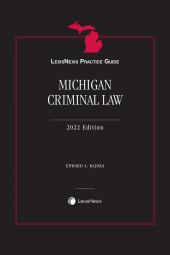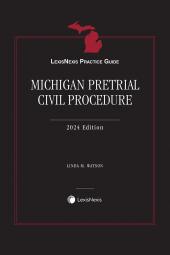LexisNexis Practice Guide: Michigan Criminal Law
Select a format
 International Order Inquiry
International Order Inquiry
Select subscription type
Terms & conditions
Subscribers receive the product(s) listed on the Order Form and any Updates made available during the annual subscription period. Shipping and handling fees are not included in the annual price.
Subscribers are advised of the number of Updates that were made to the particular publication the prior year. The number of Updates may vary due to developments in the law and other publishing issues, but subscribers may use this as a rough estimate of future shipments. Subscribers may call Customer Support at 800-833-9844 for additional information.
Subscribers may cancel this subscription by: calling Customer Support at 800-833-9844; emailing customer.support@lexisnexis.com; or returning the invoice marked "CANCEL".
If subscribers cancel within 30 days after the product is ordered or received and return the product at their expense, then they will receive a full credit of the price for the annual subscription.
If subscribers cancel between 31 and 60 days after the invoice date and return the product at their expense, then they will receive a 5/6th credit of the price for the annual subscription. No credit will be given for cancellations more than 60 days after the invoice date. To receive any credit, subscriber must return all product(s) shipped during the year at their expense within the applicable cancellation period listed above.
The total price includes the product(s) listed in the Order Form and any Updates for a limited period (minimum period of 30 days) after the order is placed ("Order Window"). Shipping and handling fees are not included in the grand total price.
All shipments may be returned, at subscribers' expense, for full credit of the Price within 30 days of receipt.
Shipments may not be returned, and no credits will be issued, more than 30 days after receipt.
After the Order Window, subscribers will receive notice of Updates along with the then-current grand total price and order process as Updates become available. Subscribers will only be shipped those Updates they specifically request.
Product description
View a sample of this title using the ReadNow feature
The purpose of LexisNexis Practice Guide: Michigan Criminal Law is to describe the entire criminal law process in Michigan, from the initial case evaluation to appeals and appellate issues. The publication is targeted at both prosecutors and defense attorneys, as well as at anyone with an interest in criminal law in Michigan. The publication is also targeted at anyone who seeks the most recent knowledge and research on DNA testing and the use of DNA evidence at trial, regardless of jurisdiction.
User benefits:
Authoritative legal analysis with an expert author's practical insights, distilled from years of litigation and trial practice;
Step-by-step guidance on the many procedural issues and topics relevant to Michigan criminal practice;
Quickly points to LexisNexis resources that can help build a case;
Concise writing style and streamlined chapter format;
Many useful examples and case studies;
Abundance of checklists and Practice Tips;
Multitude of references to leading and related cases; and
A valuable guide for the experienced practitioner that is easy to use even for the novice, and for all practitioners who need to know about Michigan criminal law.
The author currently is an attorney and independent forensic science consultant specializing in DNA analysis and interpretation, forensic pathology, and forensic chemistry.
The 2021 edition ISBN is 9781663325488.
eBooks, CDs, downloadable content, and software purchases are noncancelable, nonrefundable and nonreturnable. Click here for more information about LexisNexis eBooks. The eBook versions of this title may feature links to Lexis+® for further legal research options. A valid subscription to Lexis+® is required to access this content.
Table of contents
Chapter 1 Initial Case Evaluation and Trial Preparation Steps
§ 1.01 Introduction
§ 1.02 Characteristics of Trial-Likely Files
§ 1.03 Police Investigation Distinguished from Legal Investigation
§ 1.04 Factual Consistency: An Internal Check
§ 1.05 Case Study One--Alleged CSC1 and CSC3
§ 1.06 Witness Interviewing Basics
§ 1.07 Initial Case Evaluation in the Age of Modern Forensics
§ 1.08 Take-Home
Chapter 2 Assembling a Case File
§ 2.01 Introduction
§ 2.02 Know Your Case
§ 2.03 Challenges to Investigation
§ 2.04 Case Study 2--Alleged Counts of CSC1
§ 2.05 Defense Practice Tips
Chapter 3 Forensic Science in the Information Age
§ 3.01 Introduction
§ 3.02 The Evolution of Forensics
Chapter 4 A Practical Approach to Forensic Science
§ 4.01 Introduction
§ 4.02 The First Step: Lab Reports
§ 4.03 The DNA Lab Report
§ 4.04 Case Study 3: Home Invasion with DNA Evidence
§ 4.05 DNA Discovery Checklist--Required DNA Discovery
§ 4.06 Case Study Four--Alleged Multiple Burglary Counts with Multiple Similar Acts
Chapter 5 Forensic Pathology and Medical Forensics
§ 5.01 Introduction
§ 5.02 Forensic Pathology Fundamentals
§ 5.03 Examples of Off-Label Questions for the Forensic Pathologist
§ 5.04 Question 1: How Far Away Was the Shooter When the Victim Was Shot?
§ 5.05 Question 2: Is There Anything Distinctive About the Victim's Wounds that Shed Light on the Circumstances in Which They Were Inflicted?
§ 5.06 Case Study Five--Homicide with Mutilation
§ 5.07 Question 3: Were Certain Wounds Inflicted Post- or Ante-Mortem?
§ 5.08 Question 4: How Old Was the Person in the Picture When this Alleged Child Pornography Was Photographed?
§ 5.09 Question 5: At the Time of the Vehicle Crash, Was the Deceased the Driver or the Passenger?--Case Study Six--Fatal Car Crash with Both Occupants Ejected
§ 5.10 Case Study Seven--Fatal Shooting with Conflicting Medicolegal Interpretations
§ 5.11 Case Study Eight--People v. Mark Unger--Daubert Close-Up
Chapter 6 MRE 702, 703 and Daubert Practice
§ 6.01 Introduction
§ 6.02 The Nonexclusive Daubert Criteria
§ 6.03 Peer Review and Empirical Testing
§ 6.04 Deliberate Interruption: The Evidentiary Impact of Non-Publication of Key Studies
§ 6.05 While Some Established Standards Became Obsolete
§ 6.06 Interlude--A Complex Mixture Close-Up in Michigan
§ 6.07 Enter Probabilistic Genotyping
§ 6.08 Forensic Standards Abound
§ 6.09 Forensic Standards Ignored
§ 6.10 Error Rates--The New Planet Discovered
§ 6.11 Yes, Virginia, There Is an Error Rate
§ 6.12 Close-Up from the Trenches--Popular Legal Reaction to Proof of Lab Error
§ 6.13 International Data and Support
§ 6.14 The Unger Case Revisited
Chapter 7 Countdown to Trial--Prosecution
§ 7.01 Introduction
§ 7.02 Responsibly Managing Biases
Chapter 8 Countdown to Trial--The Defense
§ 8.01 Introduction
§ 8.02 Control the Controllable
§ 8.03 Training Clients
§ 8.04 Never Be Afraid to Fight
§ 8.05 Tautology Number One: The Defense Is Under Attack
§ 8.06 Item 1.0
§ 8.07 Item 2.0
§ 8.08 Item 3.0
Chapter 9 The Trial Toolbox
§ 9.01 Introduction
§ 9.02 Trial File Organization
Chapter 10 Appeal and Appellate Issues
§ 10.01 Introduction
§ 10.02 The Menu
§ 10.03 Analysis and Discussion
Chapter 11 Post-Judgment Remedies--MCR Chapter 6.500 and MCL 770.16
§ 11.01 Introduction
§ 11.02 The Basis of Post-Judgment Relief: MCR Chapter 6.500 and People v. Cress
§ 11.03 Case Study Nine--Fatal Shooting with Only Spent Shell Casings Recovered as Evidence
§ 11.04 Unconventional Tools
§ 11.05 MCL 770.16
Chapter 12 Immigration Consequences of Criminal Convictions
§ 12.01 Introduction
§ 12.02 Immigration Governing Law
§ 12.03 Common Immigration Statuses
§ 12.04 What Is a Conviction in Immigration Court?
§ 12.05 Important Immigration Terminology
§ 12.06 Grounds of Deportability
§ 12.07 Grounds of Inadmissibility
§ 12.08 Juvenile Offenses
§ 12.09 Changes to a Conviction or Sentence
§ 12.10 Ethical Considerations / Frequently Asked Questions
§ 12.11 Criminal Client Question Checklist
§ 12.12 Michigan Specific Crimes and Associated Immigration Consequences
Chapter 13 Michigan's Updated Expungement Laws Take Effect
§ 13.01 Introduction
§ 13.02 Defining Expungements in Michigan
§ 13.03 Expungement Eligibility Under Michigan Law
§ 13.04 Expunging Misdemeanor Marijuana Convictions
§ 13.05 Criminal Offenses that Are Ineligible for Expungement
§ 13.06 Expungement Procedure in Michigan
§ 13.07 Automatic Expungements
§ 13.08 Juvenile Adjudications
Table of Cases
Table of Statutes
Index
 Lexis Nexis
Lexis Nexis 
